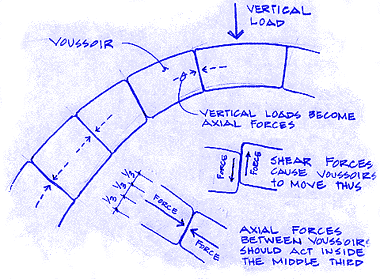| |
| |
|
| |
| |
| |
||
| |
||
| |
||
|
|
|
roman aqueducts & the arch
When the Romans built their aqueducts, they built according to a tradition of success—what had worked before or elsewhere should work here. This was not always the case, however, and without a mathematical model, it was not possible to determine whether an arch would stand or fall. We obviously do not see examples of failures, but we do know that for every success there was at least one failure. Today, the science of engineering mechanics gives us the tools we need to correctly understand the forces in and on an arch, and to determine the appropriate dimensions and details in order that the finished structure be adequately strong and stable. 
In a well - designed arch, the vertical loads supported by the arch stones, or voussoirs, become axial forces between the stones, and transfer the load from stone to stone to the foundation. Because there is no mechanical connection between voussoirs, it is important that no tensile, or "pulling" forces, and no significant shear, or "sliding" forces be generated between stones. Whether or not these forces exist depends upon the builder's ability to choose appropriate dimensions for the arch and its components. As long as the axial forces between stones remain within the middle third, and no significant shear forces need to be resisted, the arch should be solid and stable. You may find it interesting, if not surprising, that the same principles that govern the design of non-mortared stone arches also apply to continuous arches made from steel, concrete, and timber, and are closely related to the sag of a rope, or cable, such as a high-tension electrical wire or the main cables on a suspension bridge—but those relationships are best left until you've taken some fundamental courses in engineering mechanics…  Click for a larger (43k) graphic Click for a larger (43k) graphic |
